
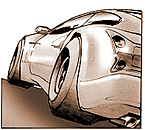
Automotive News and Reviews for the Petrolhead
Reuters Motoring Commentator
In this week's issue:
- Big Cat Diary
- Ten Top Design Touches
Now I'm not one to espouse macho clap-trap and I am also regularly stunned at the nerve of motoring writers who proclaim the latest car to be "the greatest ever", only to find it actually has several subtle flaws once the next shiny new thing comes along...
I fully understand that build-quality, fit, finish and reliability are all major considerations when deciding which £60,000 luxury saloon to buy (oh, the anguish of it all), but nobody ever turned up at the golf club in a tycoon-saloon and won admiring glances because it had NASA-approved sound-deadening or intelligent passenger air vents. Cars are meant to elicit carnal stirrings and any man who says otherwise probably still lives with his mother and spends afternoons on the end of a station platform with a flask and a notebook. Which is fine, I suppose, and sorry to be sexist about this, but I did say the XJ-R is a man's car, and by that I mean a real man's car.
Beauty is a Beast
The R is the fastest of the new XJ saloons, a range that is vitally important for Jaguar. The Big Cat's reputation has taken a bit of a battering over the past 25 years. America, for example, loves a Jaguar almost as much as Britain but the British Leyland-built crocks of the 1970s would have tried the patience of a Saint, and America, not noted for its sanctity, grew tired of parking up and watching steam billow from beneath the bonnets of their high-quality (ha!) British motors. As did large numbers of Brits, tragically symbolised by former Jaguar devotee Mike Baldwin (yes, from Coronation Street) who eventually sought solace at the wheel of a Lexus. This has irritated me for years. No Northern knicker-maker would choose a soulless (if accomplished) Japanese reproduction of a German blueprint over the aristocratic crumpetcharming beauty of a Jag. Baldwin needs a new XJ and Jaguar should get on to Granada TV and sort it out immediately.
Feline Elegance
The classic lines of the original XJ6 have once again formed the basis of the new XJ series, but subtle updating and re-working has ensured that the latest car manages to look contemporary while perfectly reasonably retaining its evocative, classic pouncing-cat stance. I notice some experts have claimed to be disappointed at the lack of a radical re-style. Get a grip. What's the need? It is a design that was so right in the first place that its prolonged distinction can be attained through sympathetic evolution, rather than regular re-invention. You tell me which car looks better the two-tonne Teuton from BMW (the latest 7 Series), with its humps, bumps and corpulent waistline; that grumpy looking three-pointed pastiche known as a Lexus LS430; or the all-new XJ saloon? The Jaguar wins a virtual no-contest because it is an optical orgasm, all feline elegance and purposeful stance.
All of which is a shame (or possibly proves that the significance of racing success is a little exaggerated) because last year Jaguar sold over 100,000 cars worldwide, for the first time ever. And with products like the new XJ-R, it is going to sell a whole lot more. The R is the proudest of all the new XJ beasts. The additional sensual muscularity of the R is utterly in keeping with its performance. It sits on exquisite 19-inch split-rim alloys that look like they may have been acquired from a Bond Street jeweller and in the dark blue colour of the test car, the R has a jaw-dropping, yet subtle, look-at-me quality. It certainly does turn heads but it does it for the right reasons. It is an automotive upper-class crook. It possesses the right clothes, the right accent and impeccable manners but underneath it all it has the attitude of a real nasty piece of work. Nasty in the sense of a 155mph top speed and acceleration to match. Keep your eye on the rear-view mirror, plant your right foot and instantly you're in a different postcode. The handling, while never quite sports coupe, belies the size and mass of such a big saloon, and even though the R is firmer than the rest of the range, the legendary Jaguar ride from the all-new air suspension remains a cut above. This Jaguar really does waft, when you're not in the mood to misbehave.
It's Been Emotional
But it wouldn't be a Jaguar if it were absolutely perfect. The verve and grace that the R engenders, from the moment you first set eyes upon it to the point at which you climb from behind the wheel, will mean everything to anyone with a soul. But open a wet boot lid in a hurry and you will fume as water splashes onto the contents within. The example I drove also had a disconcerting steering vibration under braking from high speeds. And both the horn (permanently) and cruise control (temporarily) stopped working during my week with the car. You sort of know that this wouldn't happen on the Audi, BMW, Lexus or Mercedes and it shouldn't happen at all for £58,500.
But I don't care. I would bury my head in the sand and/or get these minor irritations fixed. This would be a small price to pay to be sat at the traffic lights blipping the throttle and feeling the whole chassis rock under the straining force of the Jaguar's supercharged 400bhp. And watching as a 12-year-old boy in the back of the family hatchback next to me grinned with delight and stuck two thumbs in the air. I doubt he's ever even heard of a Lexus.
We live in such play-it-safe, homogenised times don't we?
New bands all sing, dance and moan the same; the layout of all hotel rooms is identical, irrespective of which sanitised chain they belong to; prime-time TV is nothing more than a succession of somnolent bilge, featuring shameless non-entities (famous or otherwise) eating soil for a bet, making a mess in other people's houses or going to the toilet for charity.
So, all the important things in life, then. And here's something else. All modern cars are look-alike facsimiles of each other too. Many of the world's leading brands are owned by just a handful of companies now and so, in the interests of saving money/making greater profits, manufacturers now 'share best practice' (produce lowest common denominator cars), 'strive to meet the demands of the global market' (aspire only to avoid failure at the focus group stage) and 'rationalise all market sector cost bases' (fit the same bits in every car they make). Well this is the rule, which means, of course, there must also be a few exceptions.
It is still possible to tell a Mazda from a Mini; a Renault from a Rover (if you stand directly behind one and stare at the badge) but what is it that makes one car more memorable than another? What are the clever little touches that restore our faith in design imagination? Believe it or not, there are such detail differences and, in no particular order, here are 10 of the current best:
1. Nissan X-Trail / air-conditioned drinks holders
Nissan's excellent X-Trail has two horizontal lidded boxes mounted centrally in the dashboard, into which you can slide a standard-sized can or bottle. In themselves, they are unremarkable (and why horizontal?) until you realise that they are air-conditioned, keeping your drinks chilled for as long as you need. They really do work, can be switched off if you prefer and certainly impressed during the recent hot weather.
2. New Jaguar XJ / electronic handbrake
The remarkable new Jaguar XJ saloon has an electronically operated parking brake, the control for which is located just fore of the transmission shift. This control is a simple aluminium triangle that requires no more than a delicate flick up or down to engage/disengage. Except that you rarely need to bother, because when you remove the ignition key, it engages for you and also releases automatically as you pull away. Ingenious, if less than helpful for handbrake turns.
3. New Jaguar XJ / electrically adjustable pedals
It is only to be expected that the new XJ saloon would include electrically-adjustable seats and steering column, but this latest Big Cat's driving position can be optimised still further through the electric adjustment of the brake and throttle pedals too. Short arms and long legs? No problem, it's all taken care of at the flick of a switch.
4. Alfa Romeo 147 and 156 / rear door handles
5. Seat Leon Cupra R / electrically-folding rear-view mirrors
OK, electrically-folding rear-view mirrors are not particularly uncommon these days. The new Jaguar XJ saloon (again), the fourth generation Range Rover and BMW's M3 are just three current vehicles to offer this helpful, but joyously gimmicky, feature. But so they should. Each one of those cars costs in excess of £40,000, whereas the Leon only costs a fiver under 17 grand. Helpful in narrow lanes and, more importantly, amusing to play with when queuing at the traffic lights.
6. New Rolls Royce Phantom / concealed umbrellas
The new BMW-produced Rolls Royce is quite a piece of work and, as you would imagine for a car costing in the region of a quarter of a million pounds, features some stunning touches. The self-centring RR logos on the wheels are impressive but not quite as useful as the brace of umbrellas that are neatly, and conveniently, stowed in each of the rear doors. They are also Teflon-coated so you can pop them back in when wet without fear of them rotting!
7. Range Rover Vogue / heated steering wheel
Almost everything on the new Range Rover Vogue is heated. The rear-view mirrors, lower portion of the windscreen (to prevent the wipers sticking like limpets in icy conditions), front and rear seats and there is also a neat option that allows you to turn on your Range Rover's heating system while you are still lying in bed. And then when you finally climb inside, there is no need for gloves because even the steering wheel is heated too!
8. BMW 7 Series / electrically-operated boot
Things that work 'as if by magic' are eternally impressive. The boot on the BMW 7 Series is just such a 'thing'. Many cars now have automatic boot release, but big deal the 7 Series' boot opens and closes on its own, all at the press of a button on the key fob. No need to touch anything else, it's all completely hands free. And it's a novelty that just doesn't wear off.
9. Skoda Superb / CatVision
10. Fiat Ulysse / moveable refuse container
This final example is rubbish. Or a container for the disposal of rubbish, more accurately. And while it seems rather prosaic alongside clever electronics and things that get hot (or keep things cool), it is probably the neatest idea of the lot. Fiat's Ulysse is an MPV and MPVs are designed to ferry families about. Families make a mess in cars, using them as a combined restaurant, toilet, bedroom and changing room, so doesn't it make sense to have a bin inside? The Ulysse refuse container can be moved anywhere around the flat-floored interior and what it lacks in complex technology (a lot) it more than makes up for in ingenious practicality (again, a lot).
It's difficult to say whether any of these little touches alone would make you buy any one of these cars but individually, they all impress. And if someone was to build a vehicle that had each and every one of them fitted as standard, well I know of at least one customer waiting with a deposit right now.
![]() Big Cat Diary
Big Cat Diary
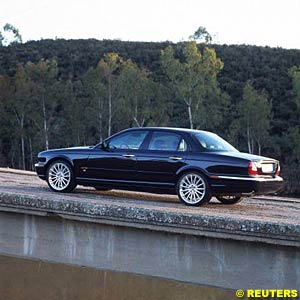 But get this. The all-new Jaguar XJ-R is a fabulous, sexy, proper man's car and it is better than a BMW 745i, Lexus LS430 or Mercedes-Benz S430. All of which may well be nonsense, of course, when it comes to comparing which of these cars has the nicest shaped boot or most harmonious indicator noise, but this is not the point.
But get this. The all-new Jaguar XJ-R is a fabulous, sexy, proper man's car and it is better than a BMW 745i, Lexus LS430 or Mercedes-Benz S430. All of which may well be nonsense, of course, when it comes to comparing which of these cars has the nicest shaped boot or most harmonious indicator noise, but this is not the point.
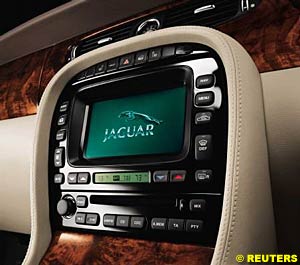 The new XJ is the seventh generation of a car that was first launched by Sir William Lyons in 1968, and is a model that accounts for almost half of all Jaguars ever produced. This latest interpretation of (surely?) a design classic is the most advanced production Jaguar ever. It is built from aluminium and offers state-of-the-art levels of strength and weight savings. Even though the new XJ is longer, taller and wider than its predecessor, it is also up to 200 kilos lighter, offering significant performance and economy benefits as part of a vastly improved dynamic driving experience. The increase in the car's size has also ensured greater head-room, leg-room and shoulder-room for all occupants.
The new XJ is the seventh generation of a car that was first launched by Sir William Lyons in 1968, and is a model that accounts for almost half of all Jaguars ever produced. This latest interpretation of (surely?) a design classic is the most advanced production Jaguar ever. It is built from aluminium and offers state-of-the-art levels of strength and weight savings. Even though the new XJ is longer, taller and wider than its predecessor, it is also up to 200 kilos lighter, offering significant performance and economy benefits as part of a vastly improved dynamic driving experience. The increase in the car's size has also ensured greater head-room, leg-room and shoulder-room for all occupants.
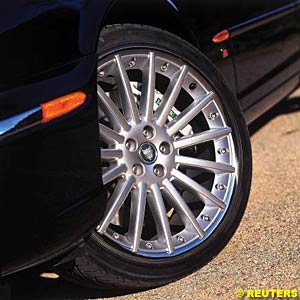 And the R, the range-topping sports version with the 4.2 litre supercharged V8 engine, is the sexiest-looking of all. R is for Racing, a part of the Jaguar heritage that evokes images of Le Mans-winning D-Types, Martin Brundle at the wheel of 1988's all-conquering Silk Cut XJR9, and thundering victories for XJS coupes in the European Touring Car series of the early Eighties. But Ford, Jaguar's parent company since 1989, decided that this critically important brand should spearhead its Grand Prix programme and so for 2000, Jaguar Racing was formed, introducing this famous name into Formula One for the first time. This was a critical period for Jaguar, with the imminent introduction of the X-Type, Jaguar's important new medium-sized saloon, and the peerless global marketing opportunity of F1 must have seemed to make perfect sense. Well, the secret of good comedy, by most accounts, is timing and Jaguar's F1 adventure has been hysterical. In three-and-a-bit seasons, a single podium finish (Eddie Irvine's third place at Monza last year) is all Jaguar has to show for an investment of tens of millions of dollars. Mention the word racing in a Jaguar showroom (or boardroom) just now and you will witness grown men petrify and shatter.
And the R, the range-topping sports version with the 4.2 litre supercharged V8 engine, is the sexiest-looking of all. R is for Racing, a part of the Jaguar heritage that evokes images of Le Mans-winning D-Types, Martin Brundle at the wheel of 1988's all-conquering Silk Cut XJR9, and thundering victories for XJS coupes in the European Touring Car series of the early Eighties. But Ford, Jaguar's parent company since 1989, decided that this critically important brand should spearhead its Grand Prix programme and so for 2000, Jaguar Racing was formed, introducing this famous name into Formula One for the first time. This was a critical period for Jaguar, with the imminent introduction of the X-Type, Jaguar's important new medium-sized saloon, and the peerless global marketing opportunity of F1 must have seemed to make perfect sense. Well, the secret of good comedy, by most accounts, is timing and Jaguar's F1 adventure has been hysterical. In three-and-a-bit seasons, a single podium finish (Eddie Irvine's third place at Monza last year) is all Jaguar has to show for an investment of tens of millions of dollars. Mention the word racing in a Jaguar showroom (or boardroom) just now and you will witness grown men petrify and shatter.
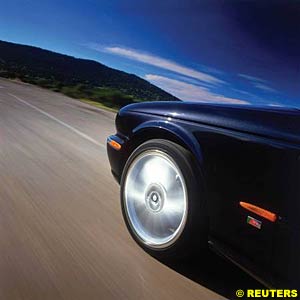 Describing the emotional and sensory pleasure to be had from this car leaves little room to detail its splendid specification but it has some wonderful features. The (optional) touch-screen command centre for the satellite navigation, telephone, in-car entertainment and climate control may look like a seaside arcade game but it is very easy to use and offers decent functionality. It all seems a lot saner than the BMW iDrive (iCrash, more like) rotary knob system that even an F-16 pilot would find dextrously challenging. The electric adjustment of the brake and accelerator pedals is, in my experience, a first and in conjunction with the similarly-powered seat and steering column adjustment, means you really can achieve the optimum driving position.
Describing the emotional and sensory pleasure to be had from this car leaves little room to detail its splendid specification but it has some wonderful features. The (optional) touch-screen command centre for the satellite navigation, telephone, in-car entertainment and climate control may look like a seaside arcade game but it is very easy to use and offers decent functionality. It all seems a lot saner than the BMW iDrive (iCrash, more like) rotary knob system that even an F-16 pilot would find dextrously challenging. The electric adjustment of the brake and accelerator pedals is, in my experience, a first and in conjunction with the similarly-powered seat and steering column adjustment, means you really can achieve the optimum driving position.
![]() Ten Top Design Touches
Ten Top Design Touches
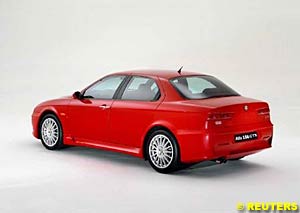 Alfa Romeo is exempt from design criticism. The troubled Italian maker continues to produce cars that stir the soul, be it aurally or visually, and on the 156 saloon they incorporated an utter paragon of design sensibility by concealing the rear door handles in the matt-black window surround, leaving the door panel itself unfettered. The net result was to lend the 156 the 'trompe l'oeil' appearance of a two-door coupe and is a neat touch that Alfa has since repeated on its 147 model.
Alfa Romeo is exempt from design criticism. The troubled Italian maker continues to produce cars that stir the soul, be it aurally or visually, and on the 156 saloon they incorporated an utter paragon of design sensibility by concealing the rear door handles in the matt-black window surround, leaving the door panel itself unfettered. The net result was to lend the 156 the 'trompe l'oeil' appearance of a two-door coupe and is a neat touch that Alfa has since repeated on its 147 model.
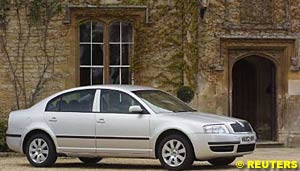 While it isn't difficult to detail the lavish specification of cars costing the thick end of £40,000, the neatest touches are those innovations you find on more real-world motors. Skoda's Superb is very aptly named with an impressive check-list of attributes and CatVision is an excellent, but simple, example. At night, the interior is gently lit by two tiny red lights positioned by the interior rear-view mirror, creating a diffused ambient glow around the driver and passenger area. The effect allows you to be more aware of the interior, without ever being distracting, and is reassuringly comforting at the same time.
While it isn't difficult to detail the lavish specification of cars costing the thick end of £40,000, the neatest touches are those innovations you find on more real-world motors. Skoda's Superb is very aptly named with an impressive check-list of attributes and CatVision is an excellent, but simple, example. At night, the interior is gently lit by two tiny red lights positioned by the interior rear-view mirror, creating a diffused ambient glow around the driver and passenger area. The effect allows you to be more aware of the interior, without ever being distracting, and is reassuringly comforting at the same time.
© 1995-2005 Kaizar.Com, Inc. . This service is provided under the Atlas F1 terms and conditions.
|
Volume 9, Issue 20
Atlas F1 Exclusive
The Acid Test: Two Weeks with Toyota
Exclusive Interview with Craig Pollock
Giancarlo Fisichella: Through the Visor
Articles
Season in the Sun: Part II
Hype
Austrian GP Preview
2003 Austrian GP Preview
Austrian GP Facts & Stats
Columns
The Fuel Stop
The F1 Trivia Quiz
Bookworm Critique
On the Road
Elsewhere in Racing
The Weekly Grapevine
> Homepage |